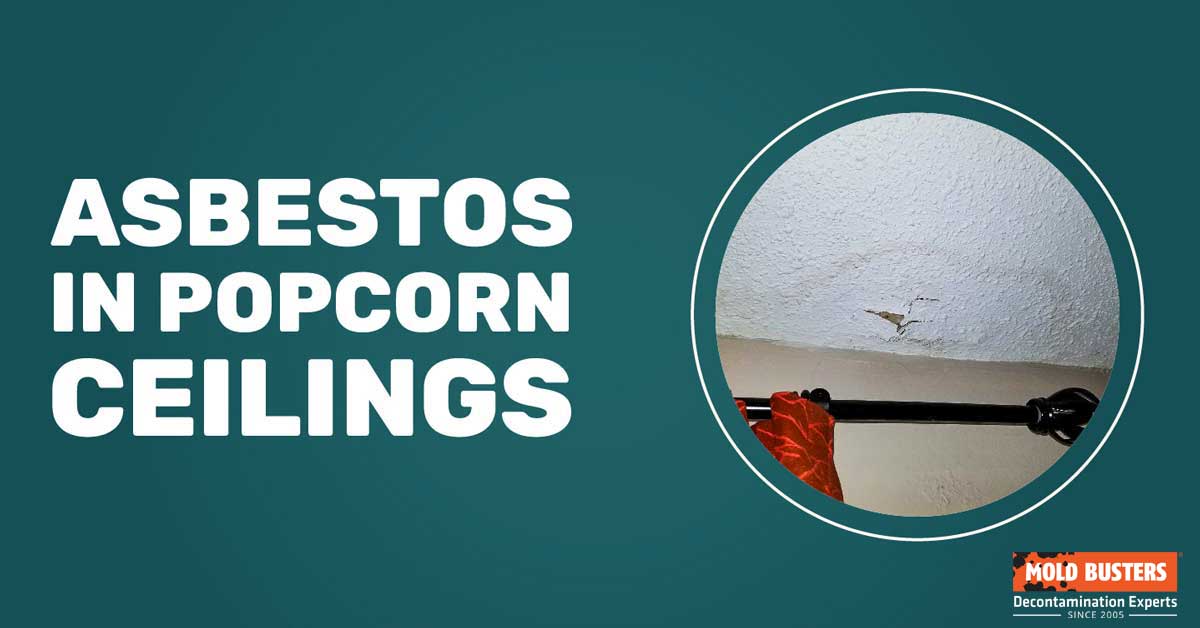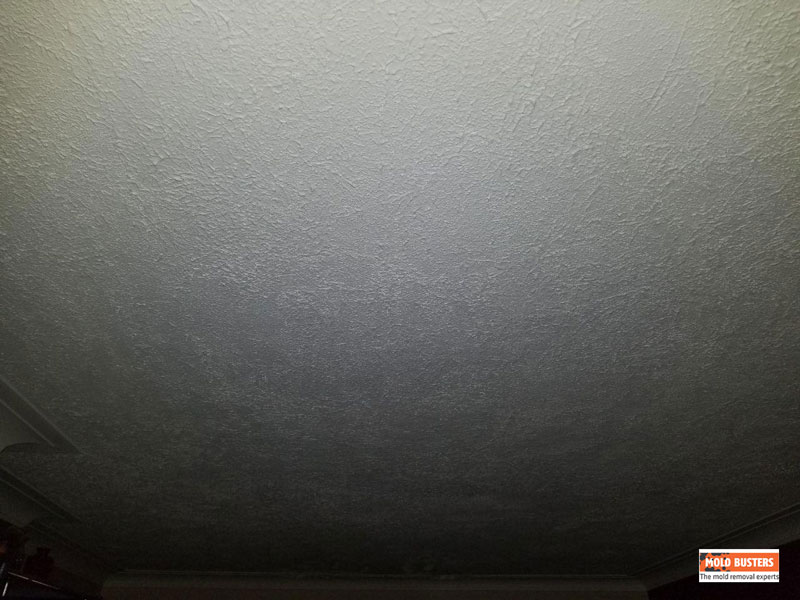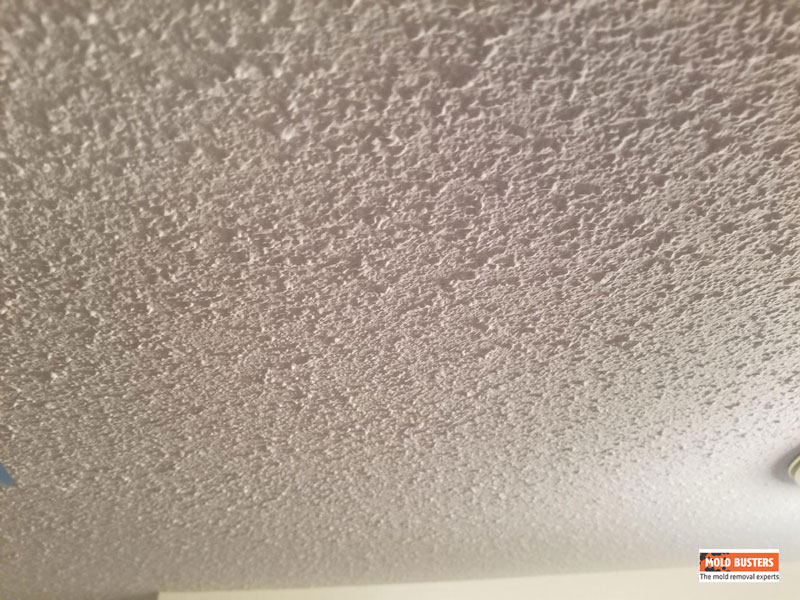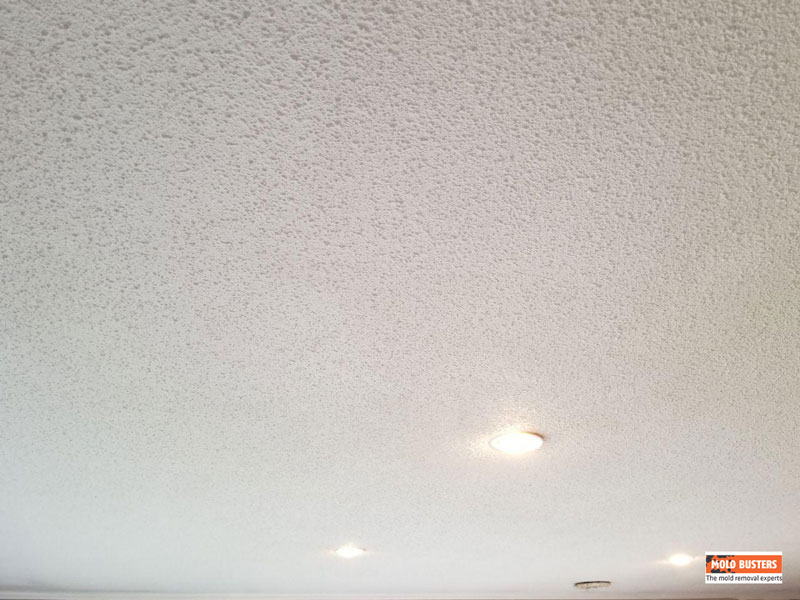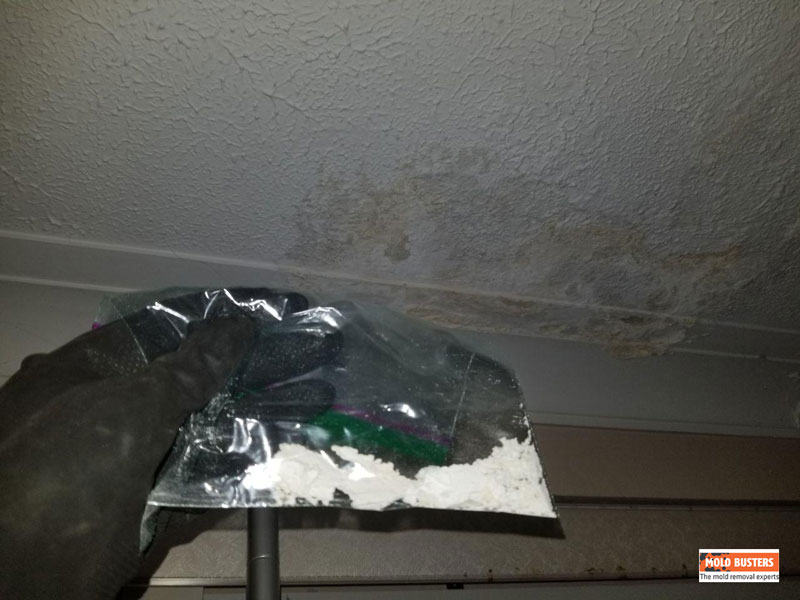Asbestos in Popcorn Ceilings
Asbestos was used prior to the Canada-wide banning of the material in 2018 because it was dirt cheap, fire-resistant, and highly durable, even used in stippled or “popcorn” ceilings.
However, based on our years of experience in asbestos testing, using this material is anything but a great value. Here’s why it’s highly dangerous to have in your home or business, plus how to get rid of it.
If you are concerned that your popcorn ceiling contains asbestos, Mold Busters is here to help. We provide fast, safe and accurate asbestos services in Ottawa and Montreal, including:
- Asbestos inspections for residential and commercial properties
- Complete testing services (asbestos bulk tests AND asbestos air tests)
Professional asbestos testing can give you fast and accurate answers without putting you at risk. Call Mold Busters to schedule a no-risk asbestos test in Ottawa, Montreal and surrounding area.
What is asbestos in popcorn ceilings?
For many older homes built between the 1930s and 1980s, contractors used a textured paint to hide imperfections in acoustic ceilings.
The most common ingredient in these textured ceilings treatments was asbestos. Asbestos was also often mixed with other materials like cement to make it even stronger.
There are many other reasons why asbestos was so commonly used in ceilings. Here are a few:
- It is a strong material but doesn’t add much weight to the building foundation,
- It is resistant to fire and sound, and
- It is cheaper than wood.
What does asbestos in popcorn ceilings look like?
Asbestos is typically white, fluffy and stringy. It is soft, strong and flexible.
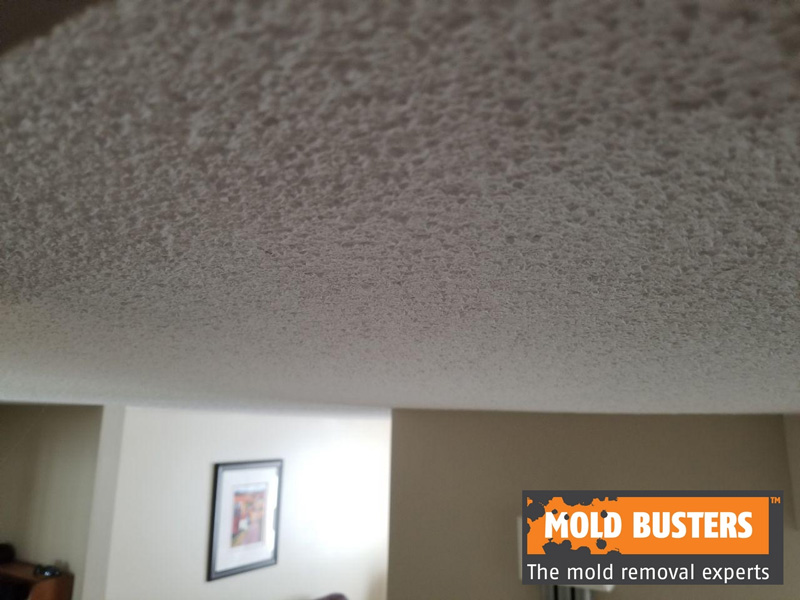
Asbestos ceilings are frequently referred to as a “popcorn ceilings” or “stucco ceilings”. As opposed to the smooth ceilings of today’s modern homes, asbestos ceilings are textured and rustic in appearance. They can be white or cream-coloured with a bumpy texture that resembles cottage cheese.
Unfortunately, a popcorn ceiling made with asbestos will look no different than any other textured ceiling. This makes identifying asbestos in ceilings difficult.
The best method for determining whether or not your ceiling contains asbestos is to collect a sample of the ceiling and get it tested by an accredited laboratory. The most common and reliable technique used to test asbestos is called Polarized Light Microscopy (PLM).
If you are concerned that your ceiling may contain asbestos, you should get a professional asbestos test to ensure safety during and after the collection of the ceiling sample. Most asbestos testing companies in Ottawa and Montreal are able to provide results of your asbestos test within a day or two.
How common is asbestos in popcorn ceilings?
Asbestos was used in a wide range of construction projects between 1930 and 1990. This means homes built in that period run a much higher risk of containing asbestos. This is especially true if they have popcorn ceilings, vermiculite insulation, certain floor and ceiling tiles, and roofing felt, among other building materials.
In addition, due to Canada’s lax laws on asbestos use before 2018, commercial properties also have a high risk of containing the hazardous material. If you are unsure, a thorough indoor environmental inspection or a professional asbestos test can give you a definite answer, as well as valuable peace of mind.
What type of asbestos is found in popcorn ceiling?
There are six types of asbestos that are used in various ways, but the most common type of asbestos found in popcorn ceilings is chrysotile asbestos, also referred to as a white asbestos.
Sometimes you will find amosite (brown asbestos) and very rarely crocidolite (blue asbestos).
Does every popcorn ceiling contain asbestos?
Not all ceilings contain asbestos, but it is very hard to differentiate between a ceiling with and without asbestos by simply inspecting them visually.
The only way you can be sure is to hire a trained professional like Mold Busters to get your ceiling tested for asbestos.
Where else can you find asbestos in your home?
If you find out that your ceiling contains asbestos, it’s very likely that the material was used in other parts of your home. Here are some other parts of the home where asbestos is commonly found:
- Also known as “mud”, asbestos may have been used as a sealing agent to help fill gaps between drywall boards.
- Because asbestos was used as a fire retardant, it is often found in concrete walls or insulating pipes, drywall, and furnaces.
- Asbestos may also be present in floor tiles, wallpaper and home siding.
The use of asbestos in drywall was also very popular, as the material was both durable and helped with noise reduction and soundproofing.
What are the health effects of asbestos exposure?
Asbestos has been used in Canadian construction for over 100 years. In fact, Canada was one of the major miners of asbestos at the height of its production. Years later, however, reports of asbestos-related disease and deaths started to emerge.
Research soon showed that the fibres of the naturally occurring material were extremely hazardous to the human body when inhaled. Exposure to asbestos was linked to cancer and other serious health conditions.
When asbestos is disturbed, the small fibres become airborne and can be easily inhaled. Sometimes asbestos can remain in the air for 48-72 hours. In a room with limited air circulation, it can even stay for several weeks following the disturbance.
While inhaling these fibres is painless, asbestos exposure over long periods of time can develop into serious, life-threatening conditions. Asbestosis, for example, is a lung disease that leads to scarring and breathing difficulties.
Asbestos exposure can also result in lung cancer, specifically mesothelioma. This type of cancer is very painful and often leads to death.
In Canada, approximately 2000 deaths per year are attributed to asbestos exposure.
Asbestos-related diseases may only develop many years, even decades, after exposure to asbestos. Everyone, from homeowners to mine workers, is at risk.
In the 1970s, contractors or miners who were regularly exposed to asbestos pushed for reform.
When was asbestos in popcorn ceilings banned?
While the exact date that asbestos was banned varies around the world, Canada only recently put an asbestos ban in place. As of December 30th, 2018, the Canadian federal government introduced legislation to prohibit the use of asbestos in any construction projects. This new law does include some exceptions, such as allowing asbestos in military applications. However, moving forward, any residential or commercial properties must be asbestos-free.
How to tell if you have asbestos in your popcorn ceilings?
As mentioned above, asbestos fibres are microscopic in size, so they are impossible to detect with the naked eye. The most accurate and reliable way to tell if your ceiling contains asbestos is get a professional to take a sample of your ceiling and send it to a third-party laboratory for analysis.
If the sample contains more than 1% asbestos, you should protect yourself and remove the popcorn ceiling from your property.
How to remove asbestos from your ceiling
If the results of your asbestos test show that your popcorn ceiling does, in fact, contain asbestos, then it’s up to you to decide how you’re going to remove it. At this point, most people wonder if this is something they can do on their own.
Do-it-yourself asbestos removal should never be performed by untrained individuals. Asbestos is a highly hazardous material that needs expert care and strict adherence to established asbestos abatement protocols. Your best bet for safe and effective asbestos removal is therefore to contact an asbestos abatement professional.
How much does it cost to remove a popcorn ceiling?
Before any asbestos removal company gives you a quote for your project, they’ll likely want to schedule an on-site inspection. This will give them a chance to assess the extent of the problem and develop a proper scope of work. Most asbestos contractors will charge per square foot for popcorn ceiling removal. The exact price will therefore depend on the size of your contamination.
How to prevent a popcorn ceiling problem?
Popcorn ceilings are very popular in older homes, so if you want to avoid asbestos in your ceiling, you should avoid purchasing a home built between 1930 and 1990. However, this isn’t always possible. If you do find yourself in a home that contains a popcorn ceiling, contact professionals to check the ceiling for any damage that could release asbestos fibres into the air.
It should be noted that asbestos is not particularly dangerous unless it is disturbed. So you do not need to remove an asbestos ceiling that is in good shape. To add an extra layer of protection, you can easily prime and paint your ceiling to seal the asbestos fibres in place. Keep in mind that paint makes it more difficult to remove the asbestos later on. (You need to be able to wet the asbestos fibres in order to safely remove them.)
Before you proceed with any renovation work to your property (especially ceiling removal), it is a good idea to schedule a consultation with a local asbestos company.

Get Special Gift: Industry-Standard Mold Removal Guidelines
Download the industry-standard guidelines that Mold Busters use in their own mold removal services, including news, tips and special offers:
Published: May 1, 2023

Written by:
John Ward
Account Executive
Mold Busters
Fact checked by:
Michael Golubev
CEO
Mold Busters

